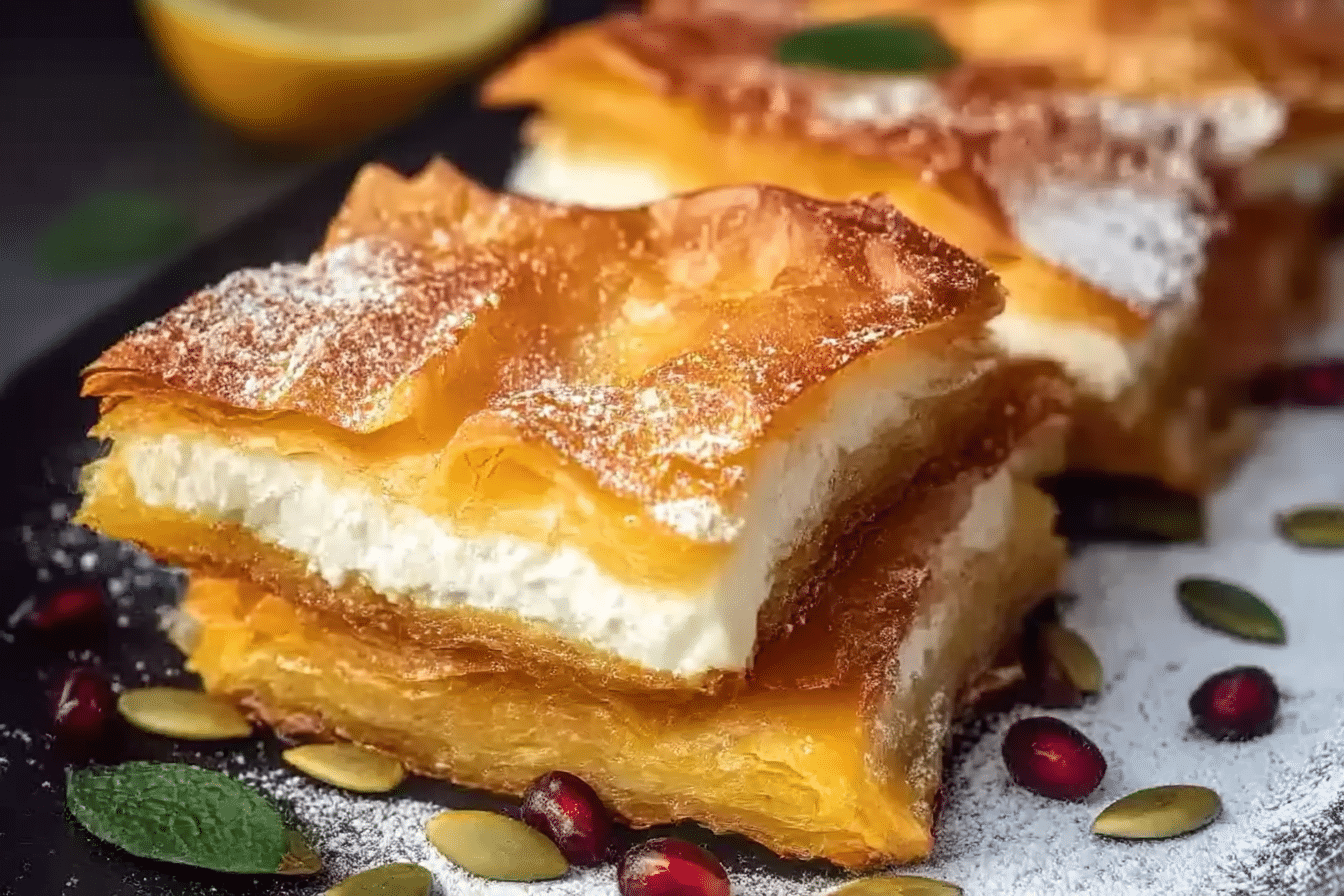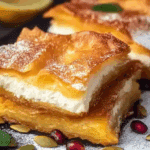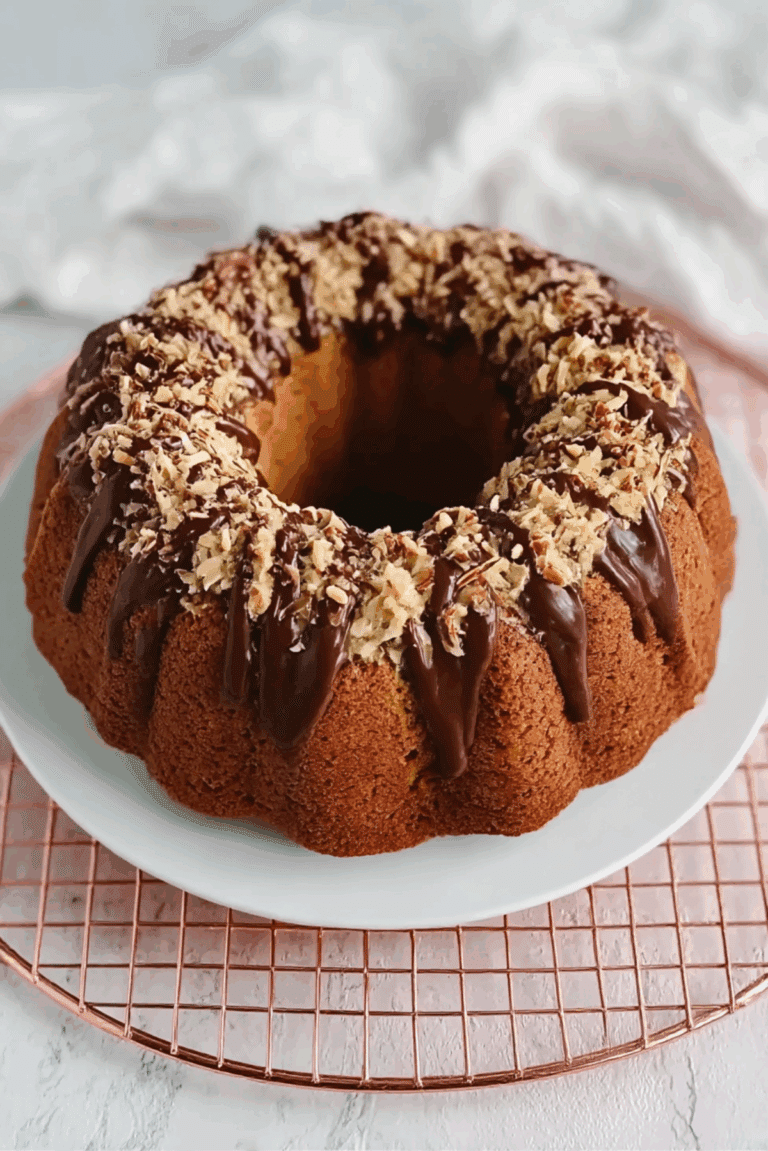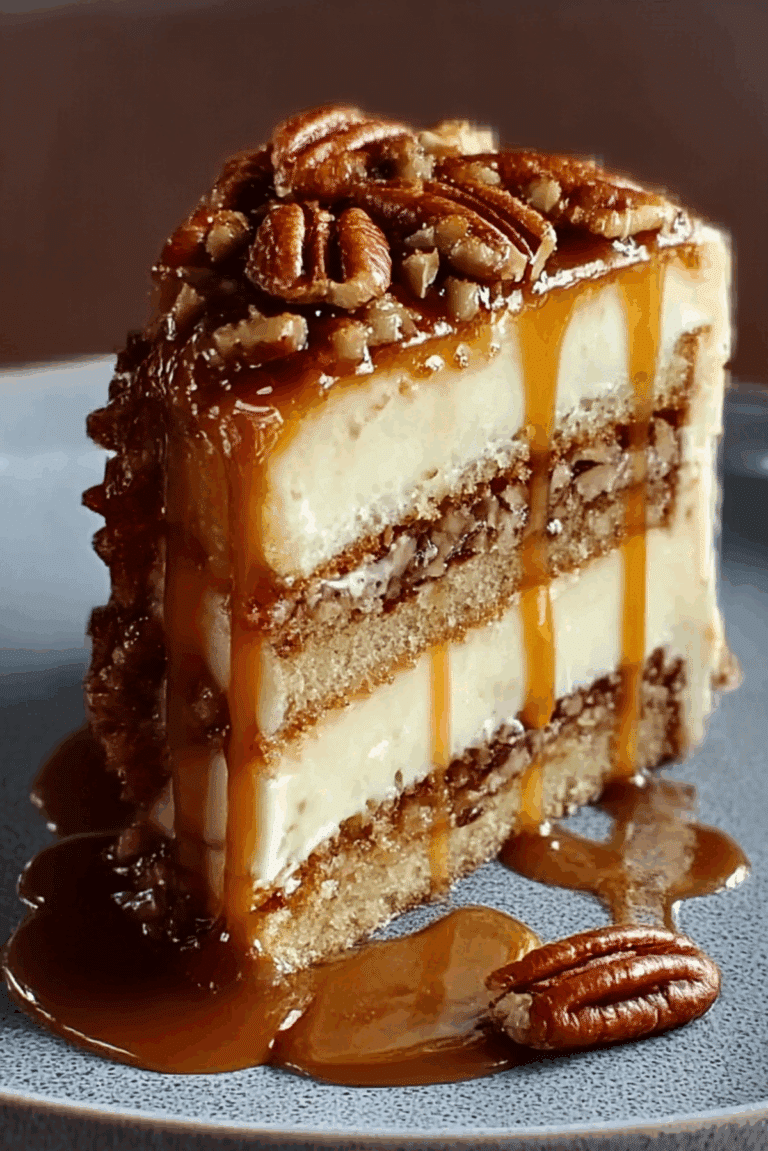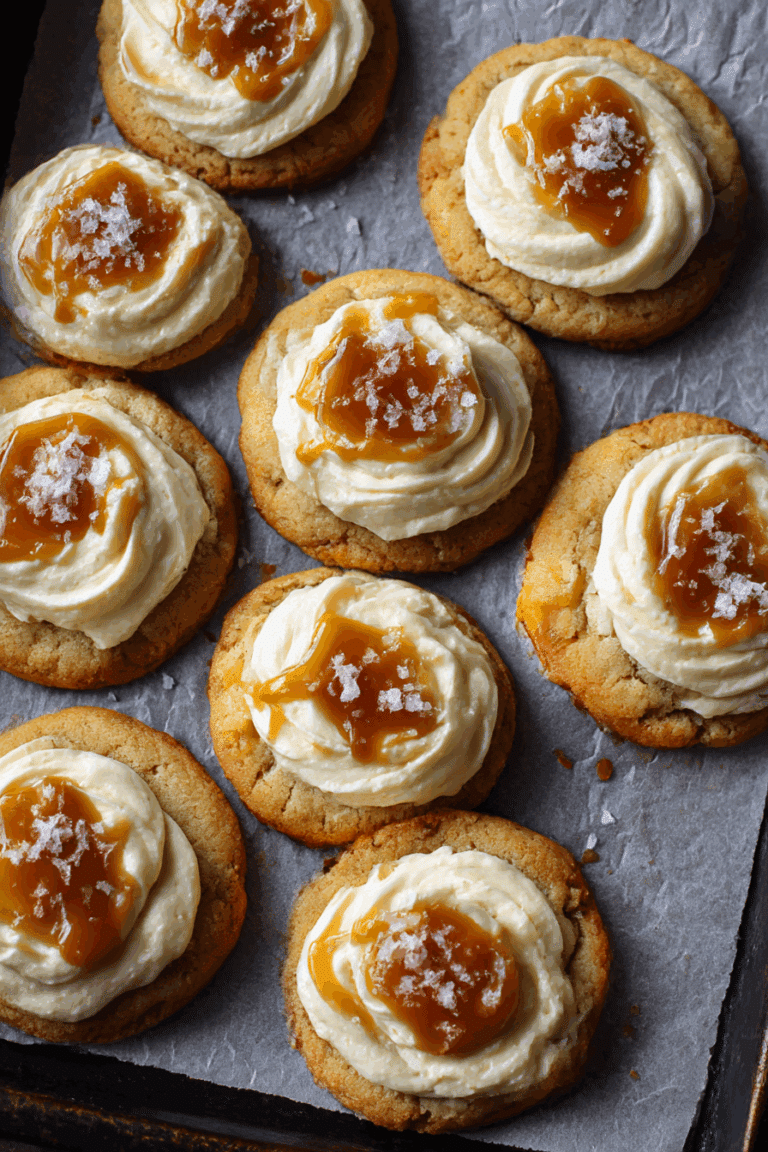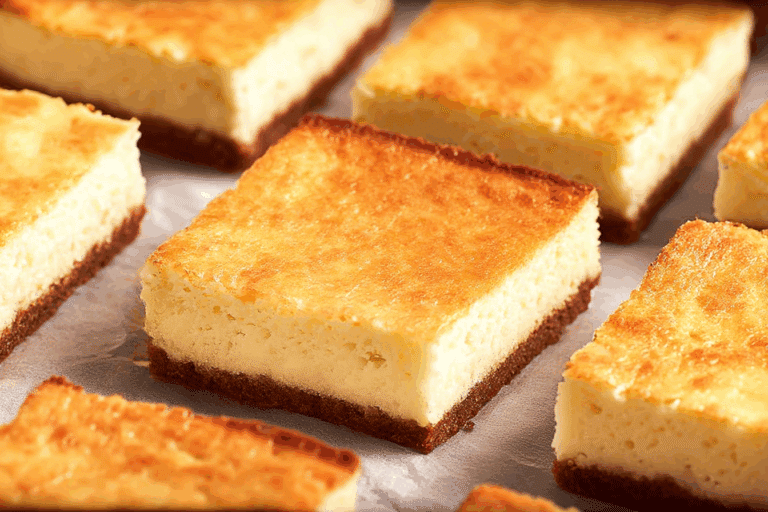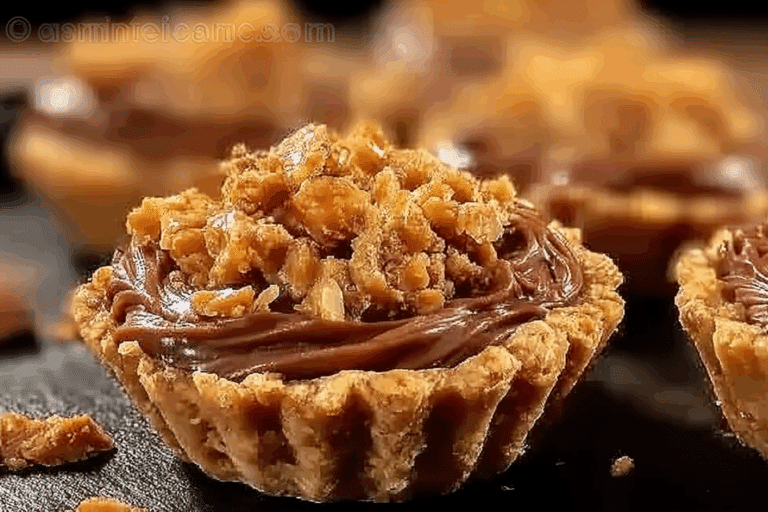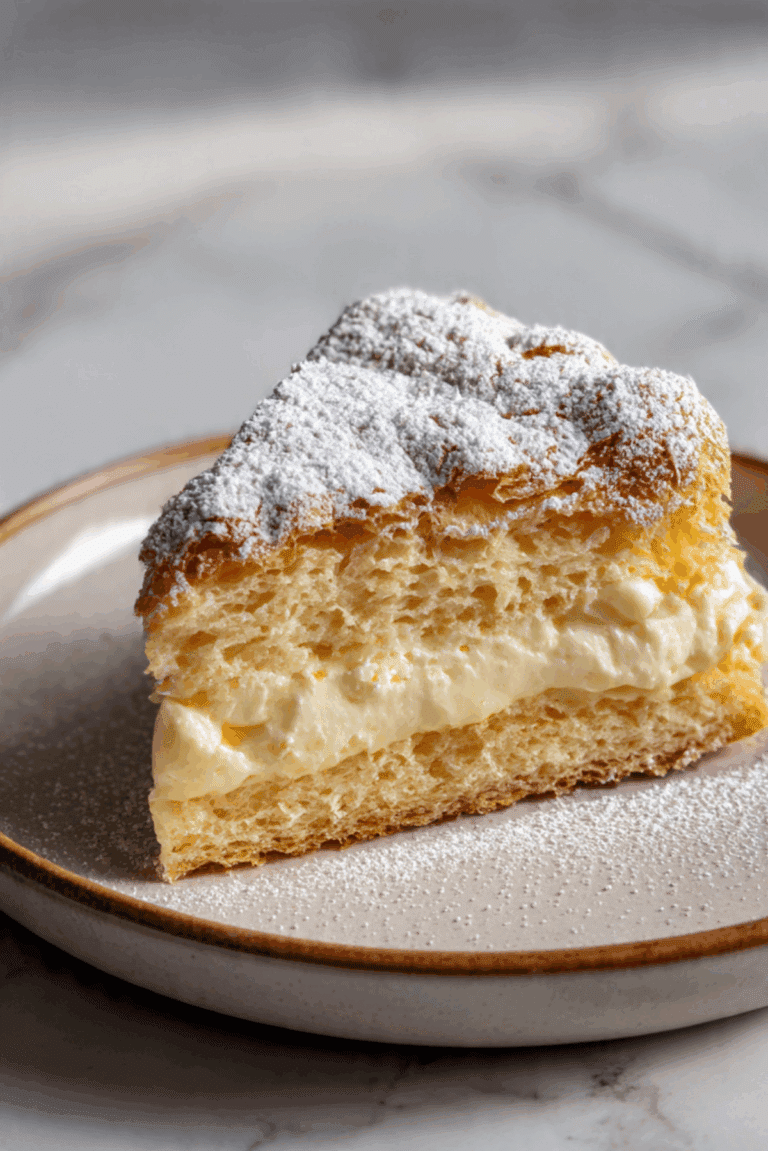Greek Bougatsa
There are few pastries as comforting and indulgent as Greek Bougatsa. Imagine layers of golden, flaky phyllo wrapped around a creamy custard filling that melts on your tongue. Finished with a dusting of powdered sugar and cinnamon, it’s the kind of pastry that makes mornings magical and evenings unforgettable. Whether enjoyed warm with coffee or as a sweet ending to a meal, Bougatsa is a true taste of Greece’s pastry tradition.
Behind the Recipe
The first time I experienced Bougatsa was in a small bakery in Thessaloniki, the aroma of buttery pastry wafting through the air as trays of freshly baked slices were pulled from the oven. The baker served it warm, the custard creamy and just sweet enough, encased in crisp phyllo that shattered with every bite. That memory inspired me to recreate this Greek treasure at home, bringing a piece of Greece’s warmth into the kitchen.
Recipe Origin or Trivia
Bougatsa is a beloved pastry in northern Greece, especially Thessaloniki and Serres, where it’s traditionally enjoyed for breakfast. The word “Bougatsa” has roots in the Ottoman era, evolving from a general term for filled pastries to the sweet custard version we know today. In Greece, you’ll also find savory versions filled with cheese or minced meat, but the sweet custard variety dusted with powdered sugar and cinnamon remains the most iconic. Bakeries often cut it into squares and serve it fresh from the oven, making it both casual and elegant.
Why You’ll Love Greek Bougatsa
Here’s why this pastry deserves a place in your kitchen:
Versatile: Serve as breakfast, dessert, or even a special holiday treat.
Budget-Friendly: Uses simple pantry ingredients like milk, sugar, and phyllo.
Quick and Easy: While it looks impressive, the steps are simple to follow.
Customizable: Add citrus zest, swap fillings, or drizzle with honey.
Crowd-Pleasing: Perfectly sweet and creamy, everyone goes back for seconds.
Make-Ahead Friendly: The custard can be prepared in advance.
Great for Leftovers: Reheats beautifully and still tastes divine the next day.
Chef’s Pro Tips for Perfect Results
To make your Bougatsa bakery-worthy, keep these tips in mind:
- Use fresh phyllo dough and keep it covered with a damp towel while working to prevent drying.
- Brush each phyllo layer generously with melted butter for maximum flakiness.
- Cook the custard low and slow, stirring constantly to avoid lumps.
- Let the pastry cool slightly before slicing so the custard sets.
- Always dust with powdered sugar and cinnamon just before serving for freshness.
Kitchen Tools You’ll Need
Gather these tools before starting:
Saucepan: For making the custard.
Whisk: Essential for smooth custard texture.
Baking Dish (9×13 inches): To layer the phyllo and custard.
Pastry Brush: For buttering the phyllo sheets.
Sharp Knife: For cutting squares before or after baking.
Fine Mesh Sieve: To dust powdered sugar evenly.
Ingredients in Greek Bougatsa
Each ingredient plays an important role in building layers of flavor and texture.
- Phyllo Dough: 12 sheets (provides the crisp, flaky pastry layers)
- Unsalted Butter: ½ cup (115g), melted (adds richness and flakiness)
- Whole Milk: 4 cups (1 liter) (forms the custard base)
- Granulated Sugar: ½ cup (100g) (sweetens the custard)
- Semolina Flour (fine): ½ cup (90g) (thickens the custard and gives structure)
- Eggs: 2 large, lightly beaten (enriches and sets the custard)
- Vanilla Extract: 1 teaspoon (adds warmth and depth)
- Lemon Zest: 1 teaspoon (brightens the custard with citrus aroma)
- Powdered Sugar: For dusting (adds sweetness and visual appeal)
- Ground Cinnamon: For dusting (adds warmth and fragrance)
Ingredient Substitutions
Here are easy swaps if you’re missing something:
Phyllo Dough: Puff pastry for a richer, thicker crust.
Semolina Flour: Cornstarch or cream of wheat.
Whole Milk: 2% milk or a mix of milk and cream.
Butter: Ghee or plant-based butter alternative.
Vanilla Extract: Orange blossom water for a floral note.
Ingredient Spotlight
Phyllo Dough: Paper-thin sheets of pastry dough, phyllo is the backbone of Bougatsa. When layered with butter, it transforms into crisp, golden layers that contrast beautifully with the soft filling.
Semolina Flour: This finely ground wheat product thickens the custard while adding a subtle nutty flavor and signature texture.

Instructions for Making Greek Bougatsa
Now let’s bring this pastry to life, step by step:
- Preheat Your Equipment:
Preheat oven to 350°F (175°C). Grease a 9×13-inch baking dish with butter. - Combine Ingredients:
In a saucepan, heat the milk and sugar until warm. Slowly whisk in the semolina, stirring constantly until the mixture thickens. Remove from heat and stir in beaten eggs, vanilla, and lemon zest until smooth. - Prepare Your Cooking Vessel:
Lay one sheet of phyllo in the baking dish and brush with butter. Repeat with 6 sheets, buttering each layer generously. - Assemble the Dish:
Pour the custard evenly over the layered phyllo. Cover with remaining 6 sheets of phyllo, buttering each. Tuck in the edges neatly. - Cook to Perfection:
Bake for 35–40 minutes, or until golden brown and puffed. - Finishing Touches:
Let cool for 15 minutes before cutting into squares. Dust generously with powdered sugar and cinnamon. - Serve and Enjoy:
Serve warm, ideally with a hot coffee or tea. Trust me, you’re going to love this.
Texture & Flavor Secrets
The magic of Bougatsa lies in contrast: the crispy, golden phyllo against the creamy custard inside. The custard is smooth, slightly sweet, with a gentle hint of citrus. The powdered sugar and cinnamon add layers of fragrance and a touch of indulgence that elevates every bite.
Cooking Tips & Tricks
Keep these in mind for a perfect bake:
- Always thaw phyllo dough overnight in the fridge.
- Work quickly with phyllo—it dries fast.
- Whisk custard constantly to prevent clumps.
- For extra crispness, bake on the lower oven rack.
What to Avoid
Here’s how to avoid common pitfalls:
- Don’t overbake—the custard can dry out.
- Avoid using cold custard—it should be warm when assembling.
- Never skip brushing butter between layers, or the phyllo won’t flake.
Nutrition Facts
Servings: 12
Calories per serving: 260
Note: These are approximate values.
Preparation Time
Prep Time: 20 minutes
Cook Time: 40 minutes
Total Time: 1 hour
Make-Ahead and Storage Tips
You can prepare the custard ahead and refrigerate for up to 24 hours. Assemble with fresh phyllo before baking. Baked Bougatsa can be stored at room temperature for a day or refrigerated for 3 days. Reheat in the oven to crisp the phyllo before serving. It also freezes well—wrap tightly and reheat straight from frozen.
How to Serve Greek Bougatsa
Bougatsa is best served warm, dusted with powdered sugar and cinnamon. Pair it with Greek coffee, a cappuccino, or black tea. For a modern twist, drizzle with honey or serve alongside fresh berries.
Creative Leftover Transformations
Leftovers can be just as exciting:
- Bougatsa Parfait: Layer pieces with yogurt and honey.
- Sweet Croutons: Bake leftover squares into crunchy bites for ice cream toppings.
- Custard Cups: Warm and crumble into ramekins for a pudding-like dessert.
Additional Tips
For an even richer flavor, try browning the butter before brushing phyllo. You can also experiment with adding orange zest or a splash of brandy extract (alcohol-free substitute) for extra aroma.
Make It a Showstopper
Presentation makes it shine:
- Serve on a marble platter dusted with sugar for elegance.
- Cut into diamond shapes for a traditional touch.
- Garnish with a cinnamon stick or lemon peel on the side.
Variations to Try
Put your own spin on Bougatsa:
- Cheese Bougatsa: Swap custard for feta and ricotta blend.
- Chocolate Bougatsa: Add ½ cup melted chocolate to custard.
- Nutty Bougatsa: Sprinkle crushed pistachios or almonds between layers.
- Mini Bougatsas: Wrap small squares individually for handheld treats.
- Citrus Delight: Use orange zest and drizzle with honey syrup.
FAQ’s
Q1: Can I make Bougatsa without semolina?
Yes, use cornstarch instead, though the texture will be slightly different.
Q2: Can I use store-bought custard?
Homemade is best, but store-bought custard works in a pinch.
Q3: Can I prepare Bougatsa ahead?
Yes, you can assemble and refrigerate before baking.
Q4: What’s the difference between Bougatsa and Galaktoboureko?
Both use phyllo and custard, but Galaktoboureko is syrup-soaked, while Bougatsa is dusted with sugar and cinnamon.
Q5: Can I freeze Bougatsa?
Yes, freeze baked slices and reheat directly in the oven.
Q6: Is Bougatsa always sweet?
No, savory versions with cheese or meat are common in Greece.
Q7: Can I make it vegan?
Yes, use plant milk, vegan butter, and cornstarch instead of eggs.
Q8: How do I know when it’s baked?
The top should be golden brown and crisp, with custard set inside.
Q9: Can I reduce the sugar?
Yes, adjust to your taste—the powdered sugar topping adds sweetness too.
Q10: What’s the best way to cut Bougatsa?
Use a sharp serrated knife to prevent crushing the flaky phyllo.
Conclusion
Greek Bougatsa is more than a pastry—it’s a taste of tradition, a celebration of textures, and a little piece of Greek hospitality on your plate. With its silky custard, crisp phyllo, and fragrant dusting of cinnamon, it’s a recipe worth keeping close. Trust me, once you try it, you’ll want to make it again and again.
PrintGreek Bougatsa
A traditional Greek pastry made with layers of flaky phyllo dough filled with creamy semolina custard and finished with powdered sugar and cinnamon. Perfect for breakfast, dessert, or coffee time.
- Prep Time: 20 minutes
- Cook Time: 40 minutes
- Total Time: 1 hour
- Yield: 12 servings
- Category: Pastry
- Method: Baking
- Cuisine: Greek
- Diet: Vegetarian
Ingredients
- Phyllo Dough: 12 sheets
- Unsalted Butter: ½ cup (115g), melted
- Whole Milk: 4 cups (1 liter)
- Granulated Sugar: ½ cup (100g)
- Semolina Flour (fine): ½ cup (90g)
- Eggs: 2 large, lightly beaten
- Vanilla Extract: 1 teaspoon
- Lemon Zest: 1 teaspoon
- Powdered Sugar: For dusting
- Ground Cinnamon: For dusting
Instructions
- Preheat Your Equipment: Preheat oven to 350°F (175°C). Grease a 9×13-inch baking dish with butter.
- Combine Ingredients: In a saucepan, heat the milk and sugar until warm. Slowly whisk in the semolina, stirring constantly until the mixture thickens. Remove from heat and stir in beaten eggs, vanilla, and lemon zest until smooth.
- Prepare Your Cooking Vessel: Lay one sheet of phyllo in the baking dish and brush with butter. Repeat with 6 sheets, buttering each layer generously.
- Assemble the Dish: Pour the custard evenly over the layered phyllo. Cover with remaining 6 sheets of phyllo, buttering each. Tuck in the edges neatly.
- Cook to Perfection: Bake for 35–40 minutes, or until golden brown and puffed.
- Finishing Touches: Let cool for 15 minutes before cutting into squares. Dust generously with powdered sugar and cinnamon.
- Serve and Enjoy: Serve warm with coffee or tea.
Notes
- Keep phyllo covered with a damp towel while working to prevent drying.
- Brush each sheet with butter for maximum flakiness.
- Thaw phyllo overnight in the fridge for best handling.
- Bougatsa tastes best slightly warm with fresh sugar and cinnamon dusting.
Nutrition
- Serving Size: 1 slice
- Calories: 260
- Sugar: 14g
- Sodium: 90mg
- Fat: 12g
- Saturated Fat: 7g
- Unsaturated Fat: 5g
- Trans Fat: 0g
- Carbohydrates: 31g
- Fiber: 1g
- Protein: 6g
- Cholesterol: 55mg

